Tag Archive for: biomarker
Expert Advice for Patients With Small Cell Lung Cancer
Expert Advice for Patients With Small Cell Lung Cancer from Patient Empowerment Network on Vimeo.
Dr. Triparna Sen, a leading small cell lung cancer (SCLC) researcher and expert, shares key advice for patients. Dr. Sen stresses the importance of working closely with your doctor, asking about clinical trials options, and the benefits of support groups.
Dr. Triparna Sen is an associate professor in the department of oncological sciences and co-director of the Lung Cancer PDX Platform at the Icahn School of Medicine at Mount Sinai in New York. Learn more about Dr. Sen.
See More from Thrive Small Cell Lung Cancer
Related Resources:

|
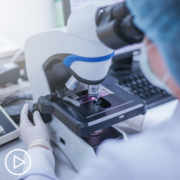
Advances in Small Cell Lung Cancer Research | Hope for the Future |
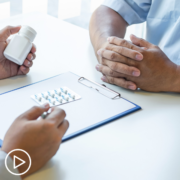
|
Transcript:
Katherine:
What three key pieces of advice would you have for a patient who has just been diagnosed with small cell lung cancer?
Dr. Sen:
First of all, I would like to say definitely, definitely work with your physician. They are trying to do their best for you. Work with your physician. Follow the treatment regimen that they give. Ask about clinical trials that you are eligible for and that you can enroll into. Then, of course, having a support group. So, there are many patient advocacy groups right now for non-small cell and small cell lung cancer.
I think being a part of such a patient advocacy group where you have people going through the same journey, I think, it really helps. It helps you sort of manage your disease better. It helps you stay hopeful when you hear about other people’s sort of prognosis and if they have durable benefits from drugs. So, I think having a support group is very important. If there is an ability for you to contribute to research in terms of giving blood or tissues, if your physician is saying that you could be eligible for that, I think a contribution to research is really key.
Because looking at the disease mechanisms in the clinical tissue is sort of where for us it is absolutely golden. We go there. We look at the disease mechanisms and tissues. If there is an opportunity for you, then I think it should definitely be explored.
Finally, I would like to say we are really trying as researchers to really understand the disease better. We’re trying to do that better. I hope and I pray that we go faster with it. But I think there is hope right now for patients with small cell lung cancer. The research is really progressing better. There are many clinical trials.
So, I think stay hopeful and have a peer support group who can take you through this quite difficult journey.
Katherine:
Why should patients consider consulting with a lung cancer specialist?
Dr. Sen:
I think it’s crucial because these lung cancer specialists really know the current state of the art treatments. They are thought leaders. They participate in trials. They actually sit on advisory boards with companies.
They are strategizing the entire treatment landscape for this disease. So, if you go to a lung cancer specialist, you’re more likely to get the most updated knowledge about what treatments are out there, what you qualify for, what are the clinical trials out there, and what are working in patients. This is not just for small cell. There are many, many trials that are happening in non-small cell also. So, whatever your diagnosis is, a specialist should be able to tell you what your options are. You really want to know about your options. Your options about biomarker testing.
Your options about screening. Your options about trials. I think a lung cancer specialist can really guide you towards that.
Katherine:
Dr. Sen, thank you so much for joining us today. It’s been a pleasure speaking with you.
Dr. Sen:
Thank you.
How Can You Access Personalized Medicine for Endometrial Cancer?
How Can You Access Personalized Medicine for Endometrial Cancer? from Patient Empowerment Network on Vimeo.
How can endometrial cancer patients access the most personalized treatment approach for their individual disease? This animated video reviews key treatment considerations, the impact of biomarker test results on therapy options, and advice for engaging in care decisions.
Related Programs:

|

|

Endometrial Cancer Treatment Decisions | Factors That Impact Your Options |
Transcript:
Endometrial cancer research is evolving quickly, leading to targeted treatment approaches and helping patients access more personalized care.
So, what is personalized medicine? Personalized medicine – also called precision medicine – is a type of care that is based on the genetic makeup and individual characteristics of a patient’s disease.
This information is gathered using biomarker testing, which identifies key markers such as genes, proteins, or other molecules in a sample of tissue, blood, or other bodily fluid. The results of this testing can give a more detailed picture of the tumor’s type, aggressiveness, and may help predict how the cancer will behave.
The test results can also identify which treatment approach may be most effective, through the presence of certain molecular markers. For example, if biomarker testing results reveal that a tumor has either high microsatellite instability (MSI high) or mismatch repair defects (dMMR), an endometrial cancer patient may benefit from immunotherapy.
Or, if the results show the HER-2 or mTOR mutation, this could indicate that the disease may respond well to a targeted therapy. And the presence of estrogen or progesterone receptors in a patient’s tumor may suggest hormonally targeted therapies may be beneficial.
In addition to biomarker test results, other factors that physicians consider when recommending a treatment approach include:
- A patient’s age, overall health, and any pre-existing conditions.
- The type, stage, and grade of endometrial cancer.
- And the patient’s preference.
When considering treatment, patients should discuss the pros and cons of each option with their doctor. And they should review potential side effects, understand how the treatment is administered, and how the therapy may impact their lifestyle.
So, what steps can YOU take to access personalized care?
- Find out if your doctor has experience treating endometrial cancer. Consulting a specialist or getting a second opinion can help confirm your diagnosis and treatment plan.
- Next, request all essential testing, including biomarker testing, and discuss how the results may impact prognosis and therapy options.
- You should also ensure that you understand ALL of the treatments available to you – including clinical trials.
- And, make sure to have a friend or loved one present during discussions, so you can talk about the information later and feel confident in your decisions.
- Finally, don’t hesitate to share your opinion and ask questions about available options. Remember, YOU should be at the center of your endometrial cancer care.
To learn more about endometrial cancer and to access tools for self-advocacy, visit powerfulpatients.org/endometrial
PODCAST: HCP Roundtable: Improving Clinician-Patient Conversations in Lung Cancer Biomarker Testing
Comprehensive biomarker testing can play a very important role in the personalized treatment for patients with non-small cell lung cancer (NSCLC). How do we improve clinician-patient conversations in biomarker testing? And how do we remove barriers that can impede an HCP’s ability to treat patients with personalized care?
Dr. Heather Wakelee, Professor of Medicine and Chief of the Division of Oncology at Stanford University School of Medicine and Dr. Leigh Boehmer, medical director at Association of Community Cancer Centers (ACCC) weigh in on this very important topic.
See More from the Empowered! Podcast
Transcript:
Dr. Nicole Rochester:
Welcome to this Empowering Providers to Empower Patients (EPEP) program. I’m Dr. Nicole Rochester, pediatrician and CEO of Your GPS Doc. In this Patient Empowerment Network program, we connect leading lung cancer expert voices to discuss enhancing physician-patient communication and shared decision-making in lung cancer care. Some of the topics we’re going to tackle in today’s conversation include the challenges and solutions for biomarker testing in the community hospital setting and in academic centers.
We’re also going to talk about removing barriers that can impede a healthcare provider’s ability to treat patients with personalized care, improving clinician-patient communication with regard to NSCLC biomarker testing, and we’re also going to explore opportunities to improve access to personalized care for all patients. I am thrilled to be joined by thoracic medical oncologist, Dr. Heather Wakelee, Professor of Medicine and Chief of the Division of Oncology at Stanford University School of Medicine. Dr. Wakelee is also President of the International Association for the Study of Lung Cancer. I am also thrilled to be joined by Dr. Leigh Boehmer, Chief Medical Officer at the Association of Community Cancer Centers. Thank you both for joining us today.
Dr. Leigh Boehmer:
Thank you.
Dr. Heather Wakelee:
Thank you.
Dr. Nicole Rochester:
So we know that biomarker testing connects the right patient to the right treatment at the right time and potentially to the right clinical trial, but there also are some challenges and interventions are necessary, and that’s going to really frame our conversation today. So I’d like to start with the general landscape, so I’m going to start with you, Dr. Wakelee, what in your opinion and expertise are the existing challenges as it relates to biomarker testing in academic medical centers?
Dr. Heather Wakelee:
Thanks for that question, Dr. Rochester. I think that the biggest challenge is making sure that every patient with a new diagnosis of advanced stage non-small cell lung cancer gets the testing done and gets the testing results back before they start treatment, right? And that’s the goal. I guess that’s more of the goal than the problem, and the challenges come in each of those different phases. First is making sure that every patient is given access to the testing, and there are barriers if the patient ends up very, very sick in a hospital setting.
There are some regulations that can make that challenging, they might be…their first encounters with the healthcare system are going to potentially be with pulmonologists, general practitioners, interventional radiology. And those people might not be aware of what needs to happen to get the tissue as quickly as possible into testing, they might not be as aware of drawing a blood test, if we’re going to do a liquid biopsy, and so if those things aren’t initiated first, when the patient gets to see the oncologist some days or even a week or two later, we’re already further down the path.
They might be starting to get symptoms, and then when you start the testing, you might have to wait longer than is really acceptable before you have the results that could inform treatment. And as you said, Dr. Rochester, the testing, when we get those molecular results back, that’s going to help us figure out what’s going on in that tumor that might change our treatment options, because there’s a driver mutation where there’s a new drug approved that’s going to be the best efficacious opportunity for that patient. And if they don’t know, they can’t start it, we also run into issues where if the patient’s symptomatic, we can’t wait, and then they get started on chemotherapy and immunotherapy, which might otherwise be a standard approach, immunotherapy is in the body, chemotherapy is in the body, the toxicity is there, and then if you later find out, oh, there was a driver mutation, your hands are a little tied, because the toxicity can be amplified if you combine agents and the immune therapy is in the system for months.
So these are some of the challenges and really the barriers…the biggest barriers from my perspective are not every patient is being tested with comprehensive testing as early as possible, right?
Dr. Nicole Rochester:
Thank you for that, Dr. Wakelee, you’ve really, really outlined how the challenges around access to testing and even the timeliness and the importance of timely testing and the fact that these patients are often kind of making their way through a series of providers before they get to the oncologist. So I appreciate that. Dr. Boehmer, I know you have a lot of experience in the community setting where we know there are a host of additional barriers, so I’d love for you to weigh in on this question, and what challenges are you seeing with biomarker testing in the community setting?
Dr. Leigh Boehmer:
Thanks very much for the question. Yeah, I think the use of precision medicine was initially touted as this opportunity to address care disparities, whether that’s in racial ethnic minorities, differences between academic and community practices, et cetera, by using the technology to try to determine treatment largely based on things like the genetic makeup of a tumor. And, unfortunately, in reality disparities have sadly only continued to grow in the setting of targeted and/or testing related to things like ability to pay and insurance coverage for testing, mistrust in the healthcare system, and historical injustices related to cancer care delivery. And there’s a significant discordance in literature between patients and clinicians understanding of the importance of biomarker testing relative to treatment planning.
So even now in 2023, as more states are passing legislation to expand coverage of comprehensive testing, we’re hearing from member programs of ACCC running up against increasing prior authorization restrictions and requirements, and there are unfortunate ramifications of that, like additional costs to programs or additional costs to patients, for example, in the setting of reflexive testing, there’s also a lot of ongoing data which suggests concerning continued racial disparities in rates of guideline concordant testing. So there’s a lot of opportunities for us to learn, yes, from what we have done in successful models of rollout of testing, but we’re still confronting some pretty major challenges and barriers, and I’ve got to say that’s true whether you’re talking about community programs and practices or academic partners as well.
Dr. Nicole Rochester:
I really appreciate you adding that layer, Dr. Boehmer. As someone who does a lot of work in health equity, I was just sharing prior to us recording that these disparities are pervasive, and now we’re learning it’s in lung cancer, and for all of the reasons that you stated, and it’s interesting that when we really start to look at our progress, and when we look at it by comparing different racial and ethnic groups, we find, as you stated, that sometimes the disparities actually widen.
And so it’s not that these aren’t great practices and precision medicine is a wonderful thing, but to your point, if we’re not ensuring that everyone has access to this new technology, then in fact, not only do we continue to see disparities, but sometimes that we inadvertently worsen them. So I appreciate you sharing that. Both of you have been on the ground floor of research in this area with regard to biomarker testing and availability and disparities. So I’d love for you to talk a little bit about the data and what does the data tell us with regard to biomarker testing? It’s important, some of the challenges that you both just stated, and so I’ll start with you this time, Dr. Boehmer.
Dr. Leigh Boehmer:
[chuckle] Thanks, I appreciate it. I’ve been privileged to work with both providers and patients’ caregivers, taking a closer look at some of the barriers and then practical solutions that might be utilized to address some of these concerns around testing. So back in 2021, ACCC used the mixed methods approach to try to understand the motivators of patients and providers, their practice patterns, their attitudes, the educational needs of patients and providers related to biomarker testing and beyond. And you know what’s really interesting, in almost 100 total provider respondents, less than half of community clinicians who responded said that they used biomarker testing to guide patient discussions.
And that was compared to nearly three-quarters of all responding academic clinicians, and it really made us start to think about…so, you know, the impetus for testing in the context of testing. In this particular research, to my earlier comments, we were actually targeting patients with non-small cell lung cancer who were uninsured, underinsured and/or covered by Medicaid. So dual eligible beneficiaries, and it was really interesting because we looked at why and how conversations were happening about biomarker testing between providers and patients, and really identified some tremendous opportunities for education around clinicians’ needs to become more familiar with guideline concordant testing and to have more practical applications of guideline concordant testing, so things like case-based examples, so then ultimately they could have optimal conversations with patients and help coordinate multidisciplinary care.
There’s also data which would suggest a disconnect between ordering testing after initial staging versus ordering testing at the time of initial biopsy. And, Dr. Wakelee, you said something that really resonated with me because if we can identify patients who need to be tested, if we can have access to testing, we still have a disconnect, and this is largely seen in community programs today where clinicians may be waiting 10 days, 14 days, even longer to receive results of testing. And you’re right, we have patients who need treatment initiated sooner than later, and you miss these opportunities because of delays, prior authorizations and a lot of other things, So the data certainly quantitatively, qualitatively is speaking to this hierarchy of problems and there’s definitely some mismatches between patient and provider perceptions of why testing happens, what it’s used for, and timing of the testing and results sharing.
Dr. Nicole Rochester:
That is fascinating, and we’re definitely going to get deeper into that, this whole patient-provider interaction, so I really appreciate you introducing that and thank you for all the research that your organization has done in this area. So, Dr. Wakelee, you’re on the academic side of things, and you also have been deeply involved in research in this area, so what would you like to offer from your perspective in terms of the data around biomarker testing?
Dr. Heather Wakelee:
Well, thanks, and, Dr. Boehmer, you have a very comprehensive answer there, I think that the differences between academic and community sometimes are broad and sometimes aren’t that big at all, and I do think we face a lot of the same challenges. It’s just…it’s making sure that when a physician is meeting with a patient, and let’s say it’s with the oncologist, that the oncologist is really mindful that any patient with non-small cell lung cancer could have a tumor with a driver mutation. I think it’s easy to stereotype and think that only certain patients are going to, and therefore we shouldn’t be testing everybody. And that gets dangerous. I think it also is a matter of where you’re in practice, and if you’re in a practice where the prevalence of the driver mutations and the tumors is low, you might just say, “Oh, I’m never going to see it,” and you stop testing, and that’s also very dangerous because we have seen in multiple trials, as we get back to that research question, that if we can identify a driver mutation…
And we know that more than half of patients who’ve developed lung cancer who have never smoked or have a light smoking history are going to have an actionable driving mutation, and even in people who do have a smoking history, of any ethnic background, they’re still 10 to 20 percent or maybe more as we identify more of these driver mutations, where that’s what’s really the force in the tumor. And if you find it and you can start someone on the appropriate targeted therapy, usually across multiple trials, the toxicity is less than you would get with chemotherapy or immunotherapy.
Usually the probability of response is over half, you know, if someone’s going to have a benefit that that’s going to help them feel better for a period of time in controlling their cancer, it really drastically changes their whole tumor outcome, they’re going to be living longer, feeling better, and ultimately that’s our goal when we’re helping someone with metastatic disease. And if you don’t know that the tumor has a driver mutation, you’re never going to give them that appropriate treatment, and I think that is the real challenge that we face, and there are multiple different angles to that, right? You have to have the physician aware of the importance of finding the mutation, altering the treatment as necessary, and giving that patient the best possible option for care.
But it also is making sure that the patients are open about this, because I think there’s still a lot of misperceptions about when we talk about driver mutations and the word mutation, making sure that people understand we’re talking about the cancer and not about the person. And in a short conversation that can sometimes be missed, and then people are afraid of getting tested, afraid of what that might mean for them or their family, and so the communication around, we’re going to test your tumor because your tumor might have a mutation that’s going to allow us to give different care. I think that’s really important that people always remember to talk about the tumor and not about the mutation in the person, that’s really, really critical.
And also to avoid that stereotyping about who do we test and who do we not test, pretty much anyone with a non-squamous, non-small cell lung cancer, their tumor needs to be tested, and many people who have a squamous cytology that’s also reasonable. So that’s the people aspect of it, the insurance barriers and the interpretation of the results, those are still there as well. And even if you have perfect communication and the patient understands and you get the testing done immediately, you still have to deal with, is it going to get covered or not? And the results come back, is it going to be interpretable or not? Because that can sometimes be tricky also.
Dr. Nicole Rochester:
Wow. I would say you two have really uncovered a lot of barriers, and it’s enough to make someone feel a little bit discouraged, I would say, however, because of the work that both of you are doing and so many others, we know that there indeed is hope. And so I’d love to shift a little bit. We’ve talked a lot about the barriers, which are many, what’s on the horizon or what positive trends have you all seen, and specifically what are the opportunities, what are some things that are either happening or that are being explored with regard to removing some of these barriers or all of the barriers that each of you have talked about? I’ll start with you, Dr. Wakelee, give us some hope.
Dr. Heather Wakelee:
All right. Great. Well, I think there is reason to have hope. Absolutely. There always is reason to have hope. And so many organizations, including ISLC, including ACCC, including NCC…I mean, you could name any organization that’s involved in cancer care and education, is really focusing on this issue of making sure that every oncologist knows the importance of doing biomarker testing for patients with non-small cell lung cancer, that we are trying to expand that not just to the oncologist, but also to the folks making the diagnosis, so they can be aware as well. Patient advocacy groups are very engaged in this as well, making sure that when someone is newly diagnosed, if they reach out to an advocacy group, one of the messages they hear is, have you asked about testing what’s happening with the tumor testing?
The more people who are aware that’s a standard of care in treating lung cancer, the more that’s going to happen, and then continuing to explore those financial barriers, and as more agents are FDA-approved, where that becomes a preferred first sign option, but you only know that if the testing’s happened, that leads to campaigning to make sure that the testing is being covered as well, you know, when you can argue, this patient isn’t getting the FDA-approved best care for their cancer because that testing wasn’t done, that’s a really powerful statement. And I think that’s what we’re seeing change happening.
Dr. Nicole Rochester:
That is incredible, thank you. Thank you so much. I can smile again.
[laughter]
Dr. Nicole Rochester:
What about you, Dr. Boehmer? I know you’re getting…your organization is doing a lot of work in this area, so tell us about some of the advances, some of the improvements and tackling some of these barriers that both of you have elucidated today.
Dr. Leigh Boehmer:
So, Dr. Wakelee, thank you for all of those hope-inducing concepts and methodologies, because I honestly believe that so many of us learn best today by seeing someone like me doing X, Y, Z, so I know I can do it as well. So I think it’s about documentation of justification of testing for prior authorization claims. I think it’s about working together with the multidisciplinary team, pharmacist, advanced practitioners, oncology-certified nurses to help manage that back and forth with testing and external pathology and laboratory companies, to make sure that results show up in the right spot in the electronic health record so that they can be interpreted, shared with patients, communicated and contextualized in real time. I think it’s about greater incorporation as we’ve seen across so many of our programs of the tenets of shared clinical decision-making, and how to have a meaningful conversation with a patient and/or their caregivers about testing and its role on treatment and drug selection, and outcomes, and progression-free survival. And there are a lot of programs out there that are doing bits of this or different points along that continuum.
ACCC, for example, building on the research I shared before, recognizes that a lot of community programs don’t have kind of operational best practices for how to incorporate biomarker testing into a patient’s journey, and so for lung, and also, for example, for breast cancer, we’re working on creating care pathways which will help multidisciplinary clinician teams integrate discussions of biomarker testing and its impact at various critical time points along a patient’s diagnosis to treatment, to survivorship or end-of-life care. And those are just examples of us not being overly duplicative, but putting all the resources in one place, talking about timing, talking about when and how to have meaningful conversations, and then doing it with health-literate, vetted resources and through a lens of equity and shared decision-making, because you look like me, you had success with it. I’m going to do it for my at-risk patients as well, because one, it’s the right thing to do. And two, you taught me how to do it, and three, you told me what success looks like so I can measure myself against you, and that’s a successful model for scalability.
Dr. Nicole Rochester:
That is wonderful. You both have nicely taken us into the next part of the conversation, and, Dr. Boehmer, you just talked about shared decision-making, and as someone who works very closely with patient advocates and health advocates, it’s so important that any effort to improve care with regard to any disease or illness, it has to involve the patient and their family, so I really appreciate you all sharing that. So, with that in mind, and as we begin to think about how the patient-provider relationship and the patient-provider communication plays a role in addressing some of these barriers that we’ve been talking about and then making sure that patients are appropriately being tested and treated, I’d love to hear from you all regarding the role of the patient-provider partnership as it relates to biomarker testing. So, let’s see, I’ll start with you, Dr. Boehmer.
Dr. Leigh Boehmer:
So I really, really think this question is critical, and I’m going to bias by saying, an exciting new position on the multidisciplinary cancer care team that we are learning about it, some of our member programs, is that of a precision medicine steward or navigator. So if you’re at all familiar with the idea of a patient navigation service or the services provided by financial advocates or financial navigators, this is really identifying that it is getting so complex in the world of targeted testing, targeted treatments today, that it literally requires in some places and settings an FTE or multiple to try to navigate testing, pathology, external labs, medical oncology, pharmacy services, nursing administration, and then, of course, patients and caregivers, and communication and context building, working with patient advocacy groups who are out there publishing great resources on testing and what they mean and targeted treatments. But trying to put all of that together, I will admit as a community clinician, as you probably see 15, 18, 20 patients a day, sometimes with as many different discrete types of cancers, it gets overwhelming.
And so, having a support person on staff who can help you manage some of that information and the patient-provider conversations, ACCC is very, very much about recognizing multidisciplinary teams of providers, so it’s critical to have navigation, to have social work providing distress screening and psychosocial support, to have pharmacists talking about targeted therapies and how they match with, to Dr. Wakelee’s points, mutations and fusions and rearrangements and everything we’re testing for with our big panels of next-generation sequencing, right? So I really want to encourage us all to utilize as patients and as team members, everybody else on the team, which is also to say patients and caregivers, are team members too, right? They have rights and responsibilities as members of their own team. And I will end with this, I say all of this, and I feel justified in saying all of this because we’ve done research at ACCC, and without that critical infrastructure, there’s potentially a real disconnect. So, for example, we asked patients with lung cancer what resources would be most impactful for you as you embark on your treatment journey, and they said things to us like psychosocial support and financial assistance.
When we asked the provider respondents a similar question in their own survey, the number one thing they identified, they thought patients needed were educational handouts or websites to go seek information about their diagnosis. Now that’s not to shake a finger at anybody or to say that you were right or you were wrong, that’s just to say, we need people who can approach this whole patient-provider construct from different perspectives, because Leigh is going to ask different questions than Heather is going to ask, than Nicole is going to ask, and that’s the beauty of multidisciplinary care coordination. We do need to come at it from different angles, different perspectives, and always make sure we’re remaining open and inclusive and asking what patients need and want right now. Because we don’t always have the answers, we have to remember that. We’re human, we have biases, it’s always better to ask and provide and then ask again.
Dr. Nicole Rochester:
You are really speaking my language, Dr. Boehmer.
[laughter]
Dr. Nicole Rochester:
And I see, Dr. Wakelee, both of us are shaking our heads the entire time that you’ve been speaking and just around this idea of multidisciplinary teams that include the patient and the family, and ideally at the center. Dr. Wakelee, do you have anything to add?
Dr. Heather Wakelee:
Hard to add. That was very impressive, Dr. Boehmer, [laughter] and highlighting that just…we talk about multidisciplinary sometimes, the first version, some people think of it’s just it’s a team of a few different types of doctors. And obviously that’s not at all what we’re talking about, this is to provide the best possible care for a patient dealing with cancer, that physician-to-patient interaction is critical, but the patient to physicians to family is critical. And then you’ve got to also think about all the psycho-social needs and whether that’s going to be with a social worker or… We have a lot of people working in oncology who are psychologists and psychiatrists particularly focused in that because the coping with the disease is such a big part of it. And it’s also the pharmacy teams and the nursing teams. It is…multidisciplinary is many, many different levels of circles, but at the core, it’s the patient and family and the primary physician, that’s kind of the way I think at it, but I’m an oncologist, so perhaps I’m a little biased in my viewpoint there.
But it’s that communication right there where you sort of have all of the information that the physician’s holding, that’s coming from all of the different treatment disciplines, and then you’ve got all the information that the patient’s holding, that’s coming from their understanding of them and all of their other aspects of their life, and that’s sort of that interaction at the core, and making sure that both sides are seeing each other and seeing all of the other layers of that, so that you could make sure that at each point the recommendations and what the patient is actually doing, everyone’s coming from a point of understanding. I think, to me, that’s the most critical piece. And you don’t have that understanding if you don’t also have all the information you need about the tumor, and you’re not making that right decision if you don’t have all the information you need about all the aspects of who that patient is as a person, and that goes into their decisions as well, and that’s to me, that’s what we’re aiming for, right?
Dr. Nicole Rochester:
Absolutely, you all have done such an incredible job really highlighting the importance of involving the patient and family, involving this multidisciplinary team, which as you said, Dr. Wakelee, it’s not just a bunch of different types of doctors. So before we conclude, I just want to talk a little bit about that communication, because most of you have shared how important that communication is, and we know that there are challenges, inside and outside of cancer with regard to communicating with patients, and certainly as a physician that some of the complexity of the topics that you all have discussed I would admit is even a lot for me, and so we can imagine that for someone without any medical training, this is very difficult, these topics of biomarker testing and genetics and mutations and precision medicine. So I’d love for you, Dr. Wakelee, to start by just sharing some best practices, things you’ve learned over the years with how can providers who are watching this program really engage in effective, thoughtful conversations with patients and their family members about biomarker testing?
Dr. Heather Wakelee:
So that’s a great, great question. And really, the communication is to me, like I said, the core there, when I’m talking about biomarker testing with the patient, I usually try to frame it from the context of what makes the cancer different than the rest of you. And what we’re trying to figure out is what is it about the cancer that makes it different than the rest of you, so we can then target what’s different, and hopefully with that, being able to control the cancer without harming the rest of you. So that’s sort of one framework of it, and depending on the patient’s level of understanding, and then sort of layer in different levels of…for people who are understanding DNA and mutations, then you can start talking about those specifics, and for folks who don’t necessarily want to think about it that way, or haven’t had the education about it that way, then just starting from that framework. And I think about it this way too, is how is the cancer different than the rest of the person? And what can we do to therefore attack the cancer differently than we would the rest of the person?
And then from there, if there is a mutation or a translocation or something else that we found, can use the name of that gene and say, “This is different in the cancer than in the rest of you, and this is a targeted therapy that’s going to go after that, and it’s going to work for a period of time, but the cancer is always evolving.” And so we kind of plant that seed from the beginning also, that it’s not curing, that the cancer continues to evolve, and eventually it’s going to change in a way where that doesn’t work, but for right now, that’s the best treatment. So that’s how I’m going about with that communication with people on it. And then, again, I practice in Silicon Valley, so a lot of people will come in with books, practically, of all the research that they’ve done, and so that’s a very different conversation than someone who comes in and says, “Whatever you think is best, doc.” And even when I hear that, which I don’t happen to hear too often anymore, I really feel it’s critical that the patient is still understanding, why are we picking this treatment for your particular cancer, and what are our expectations from it?
Dr. Nicole Rochester:
I really appreciate the plain language, and I think that’s important, and also your acknowledgment that patients come to us with different levels of knowledge and expertise, and so really it’s about meeting them where they are, so I really appreciate that. And, Dr. Boehmer, we’re going to allow you to wrap up on this topic, I know that the Association of Community Cancer Centers has done research about what patients want to hear and some of the biases around providers, maybe thinking that patients don’t want or don’t need some of this information, that it may be too confusing for them, so I’d love for you to share some knowledge around your experience in this area and some best practices around communicating with patients.
Dr. Leigh Boehmer:
Thanks very much, I appreciate the opportunity, I’ll try and keep it targeted. I think number one, Dr. Wakelee, you’re correct. We have visual learners, auditory learners, we have people that want more direction and less direction, so simply starting by asking, how do you prefer to learn? It’s a wonderful place to start. It could be drawing pictures, it could be giving them that academic print out of literature published in a cutting-edge journal. But we need to know how patients learn and respect the fact that we’re all individuals and we as providers talking to patients may need to alter our approach based on different patients’ characteristics. I also think our research has shown that consistent terminology must, must be utilized, biomarker testing, molecular profiling, next-generation sequencing, mutation analysis, whatever it is, that you have decided to make your consistent terminology, please in your teams, then in the next level of teams, then in your health system, and then with your colleagues, talk about what it is, why it is, does it go against another group or is it in agreement with A, B, C groups. Because we have to, as a collective, really agree on and start utilizing consistent terminology, because until we do, we’re just continuing to stir the pot and cause confusion amongst patients, caregivers, other patient advocacy organizations and ourselves.
The other thing I’ll say, at ACCC, we’ve got a lot of resources aggregated in one place about shared decision-making, what it is, how to do it, how to assess yourself, health literacy, how do you evaluate your program to make sure you’re asking the right questions before you ever, ever have a conversation with a patient about biomarker testing or different targeted treatments for patients with non-small cell lung cancer? There’s little things that you can do today that’s so important. Little things you can do today that will make a positive influence on your patients’ outcomes and experience just by asking, addressing your own biases, being inclusive with your language and using consistent terminology. All of that is on our website and it’s truly incremental. Go easy on yourself, we’re all learning here, and acknowledging your bias and trying to be more inclusive is very, very worthwhile, and it’s okay if it’s small steps every single day made.
Dr. Nicole Rochester:
A wonderful way to end this program. I have learned a lot as always, I’m sure that those of you watching have as well. We have talked about the challenges around biomarker testing on the clinician side, on the patient and family side, we’ve explored some amazing solutions to some of these challenges and barriers, and I just want to really thank both of you for being here, and lastly, give you an opportunity if there’s something that you really feel like we should have talked about that we didn’t get to. Any closing thoughts or anything that you want to leave the audience with. And I’ll start with you, Dr. Wakelee.
Dr. Heather Wakelee:
Thanks. I think just to make sure everyone is always thinking, if you’ve got a patient and they’re coming to see you and they have lung cancer, that you’ve done the biomarker testing, that the patient understands about it, that you’ve had an opportunity to include that as part of the conversation whenever you’re talking about treatment.
Dr. Nicole Rochester:
Thank you, Dr. Boehmer.
Dr. Leigh Boehmer:
The only thing I would add is that if you’re thinking about creating resources, if you’re trying to target at-risk populations or communities in your area, please always, always remember to invite those individuals as you are talking, creating and disseminating. Because we don’t have all the answers, and that’s okay. I give you permission, but please invite people in and let them be a part of the discussion and the proposed solutions.
Dr. Nicole Rochester:
Wonderful. Well, thank you again to both of you, Dr. Wakelee, Dr. Boehmer, this has been an amazing conversation. And thank you again for tuning in to this Empowering Providers to Empower Patients program.
Dr. Leigh Boehmer:
Thank you.
How Have Advances in Testing Impacted AML Care?
How Have Advances in Testing Impacted AML Care? from Patient Empowerment Network on Vimeo.
Recent testing advances have dramatically improved care for AML patients. Dr. Ann-Kathrin Eisfeld discusses these improvements and why every AML patient should undergo in-depth molecular testing before making a treatment choice.
Dr. Ann-Kathrin Eisfeld is Director of the Clara D. Bloomfield Center for Leukemia Outcomes Research at The Ohio State University and a member of the Leukemia Research Program at the OSUCCC – James. Learn more about Dr. Eisfeld.
Related Resources:

|

|

|
Transcript:
Katherine Banwell:
Dr. Eisfeld, the landscape of AML has changed significantly in recent years. How have advances in testing improved patient care?
Dr. Eisfeld:
It is a different world, Katherine, honestly. I mean, I started practicing in hematology in taking care of AML patients back in Germany actually in the year 2007.
Back then, there was no other testing that was available. All we were guiding and all that we had available was morphology and cytogenetics
And very often, it was very inaccurate. And we also only had two treatment kinds available. One was intensive chemotherapy, and one was something that was just a little bit better than best supportive care. So, many patients could not receive treatment. And the increase in knowledge that we have on a molecular level in AML really did two things at once. On one, we understood we had a more finetuned understanding on which patients would respond. And the second thing is that this knowledge about the molecular landscape enabled us to have new treatments available that are sometimes in pill form that can target specific mutations in patients who carry these genetic changes.
Katherine Banwell:
Should all AML patients undergo in-depth testing like biomarker testing or cytogenetics?
Dr. Eisfeld:
Yes. Every patient should do that. It can make the difference between life and death. And it can make the difference between receiving – having a hospital stay of four weeks with intensive chemotherapy versus taking the pill at home. This is very rare that this is possible. But it is possible. And of course, you – one would not want to miss this chance if it would be possible.
Katherine:
I’d like to get your thoughts on where we stand with progress in the field of AML. What would you like to leave the audience with? Are you hopeful?
Dr. Eisfeld:
I am incredibly hopeful. I hope – when I started working in hematology, as I said at that time, it was just about when imatinib (Gleevec) came out. Which is this CML pill that really revolutionized care. And so, at that time, I would be – all patients on that bone marrow transplant service had chronic myeloid leukemia. And because they all had to undergo bone marrow transplant. Then Gleevec came, and today, there are no such patients who are see or very rarely that require such intensive care.
So, I am very hopeful that in my practice time, which hopefully –and even earlier on – that there will be a time where we find targeted therapies for almost all patients.
Breast Cancer Treatment Side Effects | What Are They and How Are They Managed?
Breast Cancer Treatment Side Effects | What Are They and How Are They
Managed? from Patient Empowerment Network on Vimeo.
What should breast cancer patients know about treatment side effects? Expert Dr. Bhuvaneswari Ramaswamy shares common treatment side effects and explains her perspective on how to manage specific side effects for improved quality of life.
Dr. Bhuvaneswari Ramaswamy is the Section Chief of Breast Medical Oncology and the Director of the Medical Oncology Fellowship Program in Breast Cancer at The Ohio State College of Medicine. Learn more about this expert here.
See More from Thrive Breast Cancer
Related Resources:
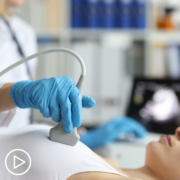
|
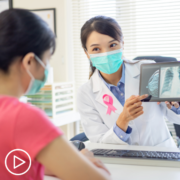
|
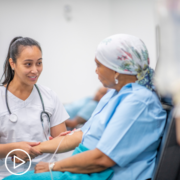
|
Transcript:
Katherine:
Dr. Ramaswamy, along with treatment can also come side effects. What are some common side effects of breast cancer treatment?
Dr. Ramaswamy:
Yeah, great question. Again, an important question for you all to consider. So, let’s divide our treatment to targeted therapy and chemotherapy. The targeted therapy could be the estrogen receptors and then the HER2 because the HER2, again, remember that biomarker. And then the chemotherapy that any patient with breast cancer could get, including, of course, the triple-negative. And then we’ll touch base a little bit later on with the immunotherapy. So, when we look at the targeted therapy with estrogen receptor, anti-estrogen receptors, of course, it’s like putting you into menopause again. It’s like so you could have hot flashes, you could have some emotional liability and you could have vaginal dryness and sexual libido could be lower.
And also you could have joint aches and pains and your bone density could go down and cause osteopenia and osteoporosis and fractures. So, those are some of the – and we can address all of those that we’ll come to later. With the HER2-targeted therapies, one of the main things will be the heart. These can affect the heart because there are some receptors that are present there that these HER2 therapies can affect the myocardial function. So, they don’t cause increase in heart attacks, but just the pumping action of your heart could go down. We keep checking your heart function to help with that. And then with the chemotherapies, other than your blood counts going down, these are acute events. Those blood counts could go down, which could put you at higher risk for infections. Again, some of the heart chemotherapies can affect the heart. So, we’ll keep an eye on that.
And, of course, fatigue that comes with all of these treatments that can happen. But some of those chronic things that can happen is also neuropathy. So, tingling, numbness in your hands and feet, even sometimes pain in your hands and feet. And then this can stay on for a little bit longer and can cause some trouble buttoning your shirt or playing the piano or putting your earrings. So, it can affect your daily quality of life and cause pain. The other important thing, which we do have now an option is also hair loss. I know that is something hard for age. It’s so hard for women to lose hair and the consequence of being identified differently and not having that – when you look at the mirror, it’s a constant reminder.
So, we do have something called a scalp cooling that you could take an option and discuss with your doctors whether that how helpful that’ll be for your type of chemotherapy and whether you could use it and you can – but 60 percent of the time not lose all your hair and need a wig. So, that is something that you can address. So, broadly, these are the issues that can happen. Again, this is very broad. Depending on your treatment, you still need to talk to your doctors.
Katherine:
How can some of these side effects be managed?
Dr. Ramaswamy:
So, the key thing is to be first thing that I want to advise all our patients is that be vocal about your side effects. Okay? Sometimes we all think, okay, they did tell me I’m supposed to have all the side effects. I just need to keep quiet about it. That’s not what is important. And I think I did miss mentioning the GI tract changes like nausea, vomiting, or diarrhea. Again you think, oh, this is our part of all chemotherapy, I just need to keep quiet. No, that’s not the case because we actually give you anti-nausea medications before the chemotherapy. So, if it’s not effective, you need to have to tell your doctors, “Okay, this time I had a couple of sensations of nausea, but no vomiting.”
Or “No, I was vomiting a lot.” Whatever it is. Even if you had just nausea, it’s important to tell your doctors. If it’s diarrhea, you need to tell them. We do give you some medications, but if it’s not working, you need to tell them. And again, we always underplay the issues with sexual side effects because you don’t want to talk about that. I mean, it’s not important. No, it is important.
It’s important for your intimacy, it’s important for your life, and it’s important for you to speak because there are supportive care therapies that we can provide. Neuropathy, again, I think your doctors will always ask you, but being vocal about it, being honest about it, and talking about it is important. So, again, fatigue.
They are going talk to you about exercise, because exercise does overcome that fatigue. But if you’re not able to do it again, it’s honest to say, “No, but I didn’t do what you said last time.” So don’t feel bad about it. And there could be other ways we can improve your fatigue too. So, again, sharing those side effects is important and we can. We can address all of these side effects. Now, I’m not saying the minute we address these side effects it’s all going to go away completely, but they can get better. And it’s important for you to talk about it and get those supportive care measures.
An Expert Explains Predictive Biomarker Testing for Lung Cancer
An Expert Explains Predictive Biomarker Testing for Lung Cancer from Patient Empowerment Network on Vimeo.
What is lung cancer biomarker testing? Dr. Grace Dy defines both biomarker and molecular testing and explains how these test results are used in lung cancer patient care.
Dr. Grace Dy is Chief of Thoracic Oncology and Professor of Oncology in the Department of Medicine at Roswell Park Comprehensive Cancer Center in Buffalo, New York. Learn more about Dr. Grace Dy.
See More From INSIST! Lung Cancer
Related Resources:
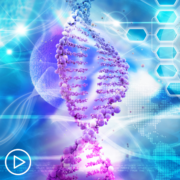
|
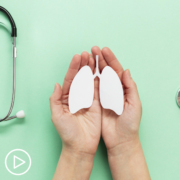
|

|
Transcript:
Dr. Grace Dy:
My name is Grace Dy. I’m a thoracic medical oncologist at Roswell Park Comprehensive Cancer Center here in Buffalo, New York.
Katherine Banwell:
Thank you for being with us today.
Dr. Grace Dy:
Thank you for having me.
Katherine Banwell:
What is biomarker testing, and is this the same as molecular testing for non-small cell lung cancer?
Dr. Grace Dy:
That’s a very good question. So, let’s first maybe define what biomarker means. So, biomarker is an all-encompassing term relating to a measurement of a biological parameter. That’s what it means.
So, you can actually have biomarker related to imaging. So, it’s not specific to a particular test. But what it’s trying to do is to guide doctors in making decisions. So, you can have, for example, a PET scan as a biomarker to indicate the effectiveness of therapy.
So, it’s not specific to a test. So, it’s a broader scope. But in cancer, generally, it’s used interchangeably with molecular testing. And molecular testing is a more focused test on the genetics of the cancer.
In some aspects, sometimes it also refers to testing for proteins, characteristics of different proteins in the cancer. Again, to help doctors generally define what might be a better treatment option that is personalized to the patient’s cancer.
In some instances, the biomarker can also be what we call prognostic, meaning independent of what we do with the treatment, it may define to us how well a patient will survive or have their outcomes, whether they have treatment or not.
So, those are maybe the nuances between a predictive versus a prognostic biomarker. But for all intents and purposes, the most common test that we use for lung cancer patients are what we call predictive biomarker testing. Molecular testing is one of the ones that we often commonly request to help us define treatment modalities, especially in non-small cell lung cancer.
The Latest Lung Cancer Research Updates From ASCO 2022
The Latest Lung Cancer Research Updates From ASCO 2022 from Patient Empowerment Network on Vimeo.
Dr. Tejas Patil from the University of Colorado Cancer Center shares the latest news in lung cancer research and treatment from the 2022 American Society of Clinical Oncology (ASCO) Annual Meeting, including an update on immunotherapy.
Dr. Tejas Patil is an academic thoracic oncologist at the University of Colorado Cancer Center focused on targeted therapies and novel biomarkers in lung cancer. Learn more about Dr. Patil, here.
See More From INSIST! Lung Cancer
Related Resources:

|

|
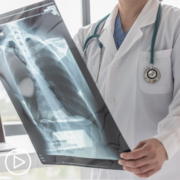
|
Transcript:
Katherine:
Researchers came together earlier this summer at the annual ASCO meeting. Were there highlights from the meeting that lung cancer patients should know about?
Dr. Patil:
Right. So, the ASCO ’22 meeting this year had some really interesting publications. So, for me, the key publications that I thought were kind of interesting from ASCO ’22, 2022, one was a publication looking at the role of immunotherapy in patients who are – have a very high PD-L1 expression, so greater than 50 percent. And there’s –
Katherine:
Reminds us what PDL is.
Dr. Patil:
Oh, yes, of course. So, PD-L1 is a biomarker. It’s a predictive biomarker that lets us know whether some patients will benefit from immunotherapy. It’s also prognostic because if patients have a high PD-L1 score, they tend to do better with immunotherapy than patients who have a low PD-L1 score.
Katherine:
Okay.
Dr. Patil:
Now the interesting data that was presented was a pooled analysis of all the immunotherapy trials to date. And there’s been this ongoing question in lung cancer as to whether patients should get chemo with immunotherapy or whether they should just get immune therapy alone.
And this study showed that if you have a very high PD-L1 score, it is potentially possible to just use immune therapy and forgo chemotherapy. And I thought that was a very interesting analysis.
There’s also several other papers that came out as well. Mostly there was a lot of interest in something called circulating tumor DNA. So, let me just take a step back. This is a type of molecule that can be detected in the blood that can help determine whether cancer is present in your blood or not. And there was a lot of publications at ASCO looking at using a concept called minimal residual disease.
So, when we treat patients with early-stage lung cancer, a big question is how do we know they’re cured or not cured? And a lot of abstracts and publications this ASCO were looking at this concept of minimal residual disease. So, if I can detect some cancer in your blood after you’ve had cured curative therapies, we’re – we have a problem because there’s still cancer around and we’re detecting it in the blood.
And I think this type of approach is going to really inform how we think about early-stage lung cancer management in the future.
What Treatments Are Available for Non-Small Cell Lung Cancer?
What Treatments Are Available for Non-Small Cell Lung Cancer? from Patient Empowerment Network on Vimeo.
Dr. David Carbone provides an overview of currently available treatments for non-small cell lung cancer patients, including clinical trials, and reviews factors that influence treatment decisions.
Dr. David Carbone is a medical oncologist and professor of internal medicine at The Ohio State University. Dr. Carbone is also co-leader of the Translational Therapeutics Program at the OSUCCC – James, where serves as director of the Thoracic Oncology Center. Learn more about Dr. Carbone, here.
See More From INSIST! Lung Cancer
Related Resources:

|

|
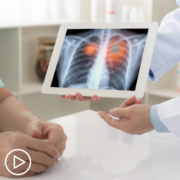
|
Transcript:
Katherine:
What are the current approaches for treating non-small cell lung cancer?
Dr. Carbone:
Well, that’s a complex question. The basic modalities are surgery, which is really still what we prefer, if we can detect it early; radiation therapy; and medical therapy.
And medical therapy can be divided into chemotherapies of some sort – what we call targeted therapies, based on genetic abnormalities in the tumor – and then, immunotherapies to harness the immune system to fight cancer. Those are the three major kinds of therapies.
Katherine:
It seems like patients really do have a lot of options, which is a good thing for them. But how do you then decide which treatment is most appropriate for a given patient?
Dr. Carbone:
Well, it’s not straightforward. When I started 35 years ago, it really wasn’t clear whether any treatment made any difference, and we actually did a large, randomized trial of doing nothing versus treating, and showed that we could improve survival by a month or two with the currently available treatments. Now, we have a huge toolbox of types of treatments and combinations of treatments. And it really requires a careful analysis of the characteristics of the tumor to pick the best therapy.
And specifically, for the adenocarcinomas, the most common type, we now do a detailed genetic analysis on all of the tumors, which can completely change the type of treatment people get and the prognosis, and result in being able to match a pill-type targeted therapy to a particular genetic abnormality with really high efficacy and low toxicity. And there are other markers we use for immunotherapy choices. It’s become quite complicated.
Katherine:
Where do clinical trials fit in, Dr. Carbone?
Dr. Carbone:
Well, I like to say that clinical trials are tomorrow’s standard of care available today, and all of the new treatments that I’m talking about for lung cancer that have made this dramatic difference in survival and quality of life: They’ve all come because of basic science research, understanding how cancers grow, designing drugs, and using them in people in an intelligent way.
Historically, we used to just grind up tree bark or dig things up from the bottom of the sea, and test them in tissue culture to see if they killed cancer cells a little more than normal cells. But today, the treatments we have are based on science, and the success of these treatments is very high compared to what they were historically.
And the way we determine whether a treatment is effective is through something called a clinical trial, where generally the new treatment is compared to the standard treatment.
And if there is no standard treatment, we still do sometimes use placebo-controlled trials, but often that’s placebo plus some chemotherapy, versus the new drug plus that same chemotherapy.
So, it’s really not a placebo-only type situation. But the trials are designed to rigorously test whether the drug improves outcomes, and are an extremely important step in developing these new drugs and finding new things to help patients.
Updates from ASH: How Biomarker Testing Has Changed MPN Care
Updates from ASH: How Biomarker Testing Has Changed MPN Care from Patient Empowerment Network on Vimeo.
MPN specialist, Dr. Andrew Kuykendall, discusses how the identification of specific biomarkers in myeloproliferative neoplasms (MPNs), such as the JAK2 mutation, have moved research forward. Dr. Kuykendall shares promising findings that were released at the 2021 American Society of Hematology (ASH) annual meeting and how this may impact MPN care in the future.
Dr. Andrew Kuykendall is an Assistant Member at Moffitt Cancer Center in the Department of Malignant Hematology. Dr. Kuykendall’s clinical and research efforts focus on myeloproliferative neoplasms (MPNs), MDS/MPN overlap syndromes and systemic mastocytosis (SM). Learn more about Dr. Kuykendall, here.
Related Programs

|

Which Gene Mutations Impact Myelofibrosis Treatment Options? |
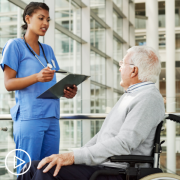
|
Transcript
Katherine:
How has molecular or biomarker testing changed the field of MPN care and treatment?
Dr. Kuykendall:
Well, I think, first and foremost just understanding – going back to 2005 and knowing that we have JAK2 mutations. I think that gave really a lot of clarity to the diagnosis and really understanding the biology of how the disease acted through the JAK-STAT pathway. And certainly, that led to the understanding of MPL mutations and then calreticulin mutations.
We’re still figuring out exactly how calreticulin mutations work. There was a great abstract, a preclinical abstract, this year talking about the impact of interferon on calreticulin mutations and how that may differ from what we see in the impact of interferon on diseases that are driven by JAK2 mutations.
Clinically, we see a little bit of difference in how those diseases respond and we may understand a little bit better about why that happens. Additionally, that’s kind of gone down to looking at these big next generation sequencing panels where we identify high-risk mutations and that can certainly change our understanding of the prognosis of these diseases.
We’re starting to get, at least in the AML world, we’re getting targeted agents that can potentially target some of these mutations such as IDH1 and IDH2 mutations that have specific inhibitors.
Those are mutations that occur in myeloproliferative neoplasm patients and convey a worse prognosis, so there are ongoing trials looking to see if we can use those IDH inhibitors in myeloproliferative neoplasms either in the chronic phase or maybe in the more accelerated advanced phase.
You know the big thing, this meeting, was actually looking at polycythemia vera patients and what’s the relevance of the JAK2 mutant allele burden. I think this is something we’ve talked about a lot as far as how significant this is. We know in chronic phase myeloproliferative neoplasms that that JAK2 mutation tends to be associated with more thrombotic complications.
There are more blood clots in the veins and the arteries. There were a couple great abstracts that looked at the really the implications of the JAK2 mutation and the fact that it is associated with more thrombosis, but maybe more venous thrombosis. That might be a big risk factor for venous thrombosis and it may be that cardiovascular risk factors, such as diabetes, hyperlipidemia that’s really what’s driving the arteriole thrombosis. It also looked at the variant allele fraction, the number of cells that have that JAK2 mutation.
One abstract showed that if you have over a 50 percent allele fraction, if more than 50 percent of the alleles have the mutation – a higher burden of that mutation that’s associated with an increased thrombotic risk even in low-risk polycythemia vera patients. Whether or not that’s enough evidence to really change the paradigm of how we treat low-risk patients is to be determined, but I think very interesting and provocative work.
What Should You Ask Your Doctor About Myeloma Testing?
What Should You Ask Your Doctor About Myeloma Testing? from Patient Empowerment Network on Vimeo.
Testing and test results may affect your myeloma care and treatment. Dr. Nina Shah, a myeloma expert, shares key questions to ask your doctor about testing and reviews testing techniques for myeloma.
Dr. Nina Shah is Associate Professor of Medicine in the Fepartment of Medicine at the University of California San Francisco (UCSF) and treats patients at the Hematology and Blood and Marrow Transplant Clinic at UCSF Helen Diller Family Comprehensive Cancer Center. Learn more about Dr. Shah, here.
Related Programs:

|
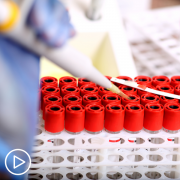
|

|
Transcript:
Katherine Banwell:
If a patient wants testing beyond the standard, what should they be asking their doctors for?
Dr. Shah:
Well, thankfully a lot of these tests can be done as a standard. We actually have some approved testing for it. So, the most important thing is to ask the doctor at all. For example, the patient may ask, 1.) “When will my next bone marrow biopsy be?” and 2.) “When I get that bone marrow biopsy, will you be looking at cytogenetics and FISH?” and 3.) “When you get the bone marrow biopsy, will you be also looking for minimal residual disease?” And finally, “What technique will you use to look for that minimal residual disease?” There are different ones that the patients might find useful to know about.
Katherine Banwell:
What are some of the different techniques?
Dr. Shah:
There are a variety of ways that we can look for minimal residual disease. One of them is called flow cytometry. What that is is you send all the cells that are in the bone marrow through a chute, and in that chute you can sort of detect one or however many cells that are – that have a specific characteristic on their cell surface.
You think of it as a bunch of balls with lollipops sticking out of it. And based on the characteristics of those lollipops, you can tell if there are any plasma cells or myeloma cells. Another thing we do with minimal residual disease, another technique, is called the next-gen sequencing or NGS.
And for that, we need to know the specific DNA sequence that is very personal to your myeloma cells. So, your particular plasma cell or the cancer cell will have a sort of sequence, a specific sequence that can be identified when you’re first diagnosed. And if you have access to that tissue, that can be sent off to the company, and they use that as sort of a template or a measure – an individual identification. And then, they scan the subsequent bone marrow samples against that to see if there’s any sequence that matches that original one, and that’s the way you can detect one in a million positive cells, if there are any.
How Is Minimal Residual Disease (MRD) Testing Used in Myeloma Care?
How Is Minimal Residual Disease (MRD) Testing Used in Myeloma Care? from Patient Empowerment Network on Vimeo.
Myeloma expert Dr. Nina Shah explains minimal residual disease (MRD) and how the results of this test may impact patient care and treatment.
Dr. Nina Shah is Associate Professor of Medicine in the Fepartment of Medicine at the University of California San Francisco (UCSF) and treats patients at the Hematology and Blood and Marrow Transplant Clinic at UCSF Helen Diller Family Comprehensive Cancer Center. Learn more about Dr. Shah, here.
Related Programs:

|

|

|
Transcript:
Katherine Banwell:
What is minimal residual disease testing, and when should it take place?
Dr. Shah:
Minimal residual disease is exactly what it sounds like. It’s the disease that you can’t see under the microscope, but it’s still there.
And I sort of equate it to the little deep food particles that are in a pot after you clean it and really, really scrub it, but still, something is in there. And that’s what it is for myeloma. And really, that depends on how sensitive your test is. We now know we can test for at least one in a million cells by some advanced techniques, and we like to test to see if there’s any disease left after certain treatments are done – for example, after a patient undergoes an autologous stem cell transplant.
Katherine Banwell:
What impact do results have on care decisions?
Dr. Shah:
Minimal residual disease testing can be useful for patients to understand the true burden of their disease. For example, it may be that there’s no more M-protein in the blood, or the light chains are normal, or even the bone marrow showed no plasma cells. But the minimal residual disease testing may show that, in fact, there are a few cells still in there, and that can help patients to decide, “Yes, I want proceed with maintenance therapy,” for example, or “No, I would not like to.” Although, we generally recommend it, patients like to have as much information as possible to make their decisions.
Understanding Your Role in Myeloma Treatment Decisions
Understanding Your Role in Myeloma Treatment Decisions from Patient Empowerment Network on Vimeo.
Many factors are considered when choosing a myeloma treatment. Dr. Nina Shah, a myeloma expert, reviews how treatment decisions are made and the patient’s role in deciding on an approach.
Dr. Nina Shah is Associate Professor of Medicine in the Department of Medicine at the University of California San Francisco (UCSF) and treats patients at the Hematology and Blood and Marrow Transplant Clinic at UCSF Helen Diller Family Comprehensive Cancer Center. Learn more about Dr. Shah, here.
Related Programs:

|

What Key Questions Should Myeloma Patients Ask About Treatment? |
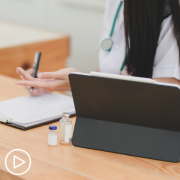
|
Transcript:
Katherine Banwell:
What are the main factors that you take into consideration before a treatment approach is decided on?
Dr. Shah:
We always have to remember that treating a patient is also treating a person. So, it’s not just about what the disease the patient has but who the patient is. And so, we take into consideration goals that the patient as well as other health factors that may take – be taken into consideration. For example, the patient may have high blood pressure or a heart condition. But regarding the disease, we really also take into consideration what the profile of the disease is, maybe how much disease burden the patient has and some genetic factors that may impact our decision-making.
Katherine Banwell:
What is the patient’s role in treatment decisions?
Dr. Shah:
The patient should always be the center of the decision-making. I think that’s a really important thing for us to remember because ultimately, it’s the patient who has to make the decision and has to withstand the treatment. Alongside of that there may be some caregivers as well, but the patient has to, 1.) understand the disease, and 2.) understand the treatment options. So, it’s best if the patient has as much information as possible.
Katherine Banwell:
Are treatment considerations different for patients with relapsed disease?
Dr. Shah:
For patients with relapsed disease, there’s a lot of things to consider that may not have been true when the patient was first diagnosed. For example, you always have to think of what maybe the patient had as a prior – excuse me, as a prior treatment, and also how the patient tolerated it.
What You Should Know About Myeloma Clinical Trial Participation
What You Should Know About Myeloma Clinical Trial Participation from Patient Empowerment Network on Vimeo.
Myeloma expert Dr. Nina Shah shares her view on why patients should consider a myeloma clinical trial and provides advice for finding and participating in a trial.
Dr. Nina Shah is Associate Professor of Medicine in the Department of Medicine at the University of California San Francisco (UCSF) and treats patients at the Hematology and Blood and Marrow Transplant Clinic at UCSF Helen Diller Family Comprehensive Cancer Center. Learn more about Dr. Shah, here.
Related Programs:

Myeloma Treatment: When Should a Clinical Trial Be Considered? |

|

|
Transcript:
Katherine Banwell:
Why should a patient consider participating in a clinical trial?
Dr. Shah:
I am a huge fan of clinical trials, as you probably figured out. And the reason for that is that it’s the only way we know how to do things. And for everything we figured out about myeloma, it’s because patients participated beforehand in clinical trials. So, of course, it’s a way to pay it forward. But aside from that, there’s an experience that a patient can have on a clinical trial that is really unlike other experiences that patients may have. For example, they will be given the opportunity to understand a lot about their disease that maybe they may not have understood before, and they may have the opportunity to try a treatment that might be beneficial.
There are no guarantees in a clinical trial, and that informed consent procedure where the doctor tells you about the risks, benefits, and alternatives, should be very comprehensive and clear. But it does allow for patients to get access to something they may not have had before. And I think one of the other things that’s important is that it’s sort of a concierge service, I would say, with clinical trials, because you have to be monitored very closely. So, of course, all your symptoms have to be known. And you get a little bit more time, I would say, when you participate in a clinical trial because we really want to know the pluses and minuses of these treatments.
Katherine Banwell:
How can patients participate in research? Where do they start?
Dr. Shah:
Participating in research is a great opportunity for patients and something that we’re grateful for as myeloma physicians. There are many ways to look on various websites. There are things like SparkCures. There’s ClinicalTrials.gov. You can look at any academic website. Almost all advocacy groups also have opportunities for you to look at clinical trials.
And any time you get the opportunity to look at patient education sites, they may have a link for you to look for other clinical trials that might be relevant to your particular stage in disease or the particular kind of myeloma that you have. When in doubt, please, if you have a chance, talk to your local oncologist perhaps to maybe refer you to a myeloma specialist. We can do this by Zoom now, so there should be no reason that we can’t be a part of your care team at least for a consultation.
How Does Biomarker Testing Impact DLBCL Treatment Options?
How Does Biomarker Testing Impact DLBCL Treatment Options? from Patient Empowerment Network on Vimeo.
Biomarker test results may help guide diffuse large B-cell lymphoma (DLBCL) treatment options. Expert Dr. Loretta Nastoupil explains how biomarkers are currently used in determining an optimal treatment approach and how research efforts could help create more precise treatments.
Dr. Loretta Nastoupil is Director of the Lymphoma Outcomes Database in the Department of Lymphoma/Myeloma at The University of Texas MD Anderson Cancer Center. Learn more about Dr. Nastoupil, here.
See More From The Pro-Active DLBCL Patient Toolkit
Related Programs:

|

|

|
Transcript:
Katherine:
What about biomarker testing results?
Dr. Nastoupil:
So, in a perfect world, we would be able to take a patient’s specific tumor, sequence it, and provide a recipe or a solution to solve the problem. And that’s what a biomarker is.
It’s something that’s unique to the patient’s given tumor that then would inform what is the best treatment. So, we’re lacking in some ways a perfect scenario. What we do have, as what I’ve mentioned, some molecular studies where we can look for specific genes or rearrangements in the genes that may help us predict the future.
And in diffuse large B-cell lymphoma, one of the most common examples of this is what we call double hit where we’re looking for two genes – MYC, which is M-Y-C, and either BCL-2 or BCL-6. These are genes that we all have. It’s just the lymphoma has moved these genes into sort of more of a prime real estate location that makes it a little bit more resistant to standard treatments.
So, if you move those genes in that tumor DNA, we call that our rearrangement. And we pick that up based off a FISH study. And if both of those features or all three of those features are there, we call it a double or triple hit.
That’s a potential biomarker that may suggest that particularly R-CHOP or standard treatment may not be the best strategy. There’s some limitations to that conclusion in that that’s not true for every patient. For about 20 percent to 30 percent of patients with double hit features, they’re going to do really well with R-CHOP.
So, that’s why we are lacking in how effective these biomarkers are. And it would be great if we had additional biomarkers that were more precise or could tell us more than just that the standard may not be optimal.
So, that’s where we’re spending a great deal of time and effort in our research efforts just trying to identify biomarkers that may tell us what’s the best approach for a given patient or what we like to call personalized medicine.



